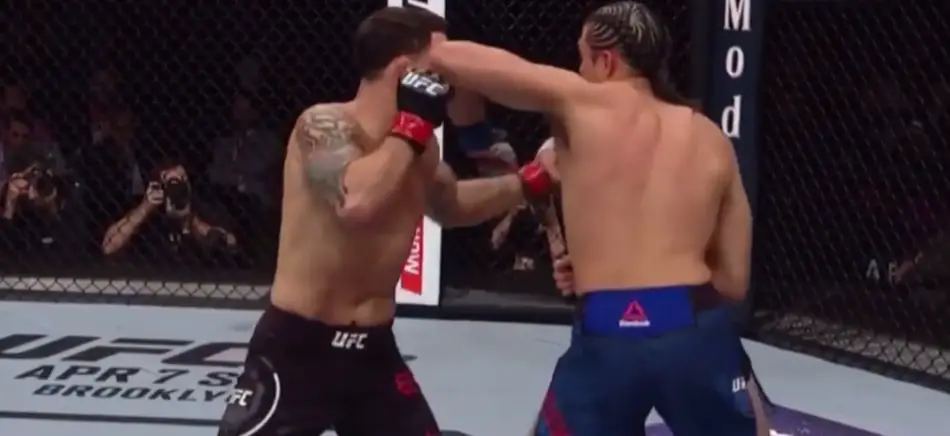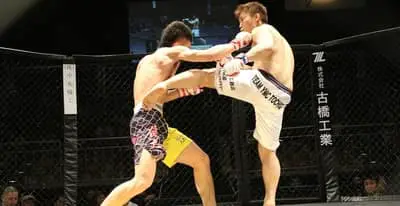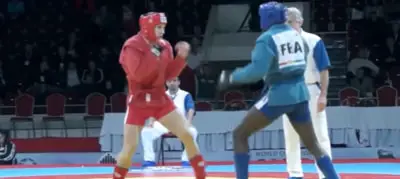
MMA is the best sport to learn for self-defense in most situations. But in others, even the highest MMA skills might not be that effective. In this article, we’ll discuss both those scenarios as well as the pros and cons of MMA for self-defense and some cool videos of MMA used in self-defense situations.
Pros of MMA for Self-Defense
The two biggest benefits of MMA is that it’s one of the most pressure tested sports and it has very little rules compared to the rest of the combat sports.
Pressure testing
Some traditional martial arts like aikido or Wing Chun aren’t that effective today because practitioners aren’t doing full-contact sparring. MMA fighters do full-contact sparring regularly whether it’s only boxing, kickboxing, grappling, or MMA rules.
That pressure testing allows them to find out which techniques work and which doesn’t. But sparring also makes you tougher. A trained MMA fighter won’t quit after taking some hard blows to the head or when rolling on the ground with someone on top of him who tries to punch him. He already experienced that.
The best of each martial art
MMA as martial art doesn’t exist. It’s just a combination of all different kinds of martial arts and its focus is on using only the effective techniques from those martial arts and ignore the ineffective ones.
For example, MMA fighters use all the punches from boxing and the boxing defense, but avoid using the traditional boxing stance because it lacks kicking defense, or the bobbing and weaving from boxing because you can easily get intercepted by a kick or a knee while doing that.
MMA fighters use Taekwondo kicks, but they also keep their hands up unlike Taekwondo fighters. MMA fighters wrestle but they don’t stay in a wrestling stance because it is too immobile etc.
Maybe the only unique situations that can be seen only in MMA are the cage wrestling (there’s no other sport where fighter wrestle on a cage) and the ground-and-pound, although there is ground-and-pound also in combat sambo.
Getting only the most effective techniques out of every single martial art makes the MMA the best sport to use in a self-defense situation or every situation that requires fighting.
Striking
Control the opponent on the ground is super important and we’ll get to that in a minute but often being able to land fast punches and cause damage can finish the fight quickly.
Often you don’t need to knock someone out to stop them. A hard jab to the face with no gloves is enough to discourage most people to engage anymore. But even if they don’t stop attacking you, if your striking is on point is not that hard to knock an untrained person out.
Most of the time they don’t have good distance management (don’t know when they are in danger and when they are safe), don’t have good timing to block/parry punches, and even don’t keep their hands up.
Leg kicks are also a great weapon for self-defense. One hard leg kick can drop a person who never experienced being kicked in the thigh/calf, it really sucks. For self-defense, knowing jab, cross and left hook plus right low kick is enough to deal with most people. In case they don’t grab you or try to take you down. Then you’ll need some grappling skills.
Ground control + Submissions
When talking about self-defense people often forget about the fact that there are situations in which you don’t want to hurt the person that bad. Why breaking someone’s arm, dislocating their shoulder, or even choking them out when you can just control them on the ground until the police come.
Below there’s a video of the former UFC champ Matt Serra and another video of a wrestling champ doing exactly that – just controlling attackers on the ground and waiting for help. Of course, you can lock them in submissions and keep them there too. MMA teaches you both to control and submit when it’s necessary.
Clinching
I can’t stress enough how important it’s clinching for self-defense. Often people don’t just start throwing punches at you. They might come close to you and start grabbing you and just trying to overpower and bully you, especially if you’re a smaller person than them.
Now it’s your mistake for letting that happen, you should’ve kept your distance first but when you get in such a situation you have to know how clinching works and have some experience clinching.
But even when you kept your distance, and the fight started with some striking, often “street fights” end up in a clinch.
Clinching teaches you how to establish a dominant position and control the opponent by breaking his posture, landing strikes while preventing him of doing that to you or even using trips to take him down.
Supper important concepts of clinching are the Muay Thai clinch (or Thai plum) where you put your hands on your opponent’s neck and start breaking his posture and landing knees to the body or elbows to the head. There are also cool trips and sweeps from that position.
When clinch boxers often use over hooks – hugging your opponent arms so he can’t punch you or headlocks (Wladimir Klitschko often used that as well as Furry). They do that because punching in the clinch isn’t allowed like in Muay Thai so their goal in the clinch is to hold their opponent, avoid taking any damage and wait for the referee to separate them.
But the best clinching we see in MMA. It’s a combination of wrestling, Muay Thai, and boxing clinches. When clinching MMA fighters use wrist control and over hooks to stop the opponent from punching them, but also under hooks to control their body, headlocks to threaten a guillotine choke or Thai plum when they want to strike in the clinch.
It’s a cool combination between striking and grappling and it’s the best clinching you can learn.
Besides hose things, MMA fighters have also better cardio than untrained people (especially when it comes to fighting), have better distance management, and boxing/kicking defense.
Cons of MMA for Self-Defense
When asking if some martial art is good for self-defense, that’s a very broad question. Are we talking about 1 vs 1 defense, defense against a bigger person, or multiple attackers? Are there weapons involved and if yes what kind of weapons? What’s the environment? Is there a lot of space to move or you are in a tight space?
As I mentioned in the beginning, MMA isn’t the solution for every self-defense situation. Now we’re going to look at the scenarios where it isn’t.
Multiple attackers
When fighting against multiple attackers, grappling, wrestling, or clinching is a no-go. Although a trained MMA fighter can beat multiple attackers or at least defend himself against them, it’s a very tricky situation.
He can do that by using only his boxing, and footwork and just punching them as they attack and then moving around. But that’s not possible every time. For example if they are in a building, let’s say a bar, that’s much harder to do then on the street.
Also if the MMA fighter gets surrounder that’s very bad. Once the multiple attackers get a grab on him it’s pretty much over. You can’t hold down, submit or ground and pound multiple people all at once.
Size Disadvantage
Although the technique gives you a big advantage, it’s limited. If the other person is double your size you don’t have much of a chance. I’m not saying it’s impossible though, there are some open weight fights where skilled fighters beat much bigger opponents, for example, this one:
But the chances of small MMA fighter vs much bigger but unskilled opponent are 50/50. Once the big person grabs you he can easily slam you on the concrete which often ends fights.
The problem with much bigger people is that everything you try might be dangerous. When striking with them, they can knock you out with just one good punch. When shooting for a takedown they can sprawl on you which with all their weight which sucks or just get a hold of you and slam you as I mentioned.
In my opinion, your best bet against a much bigger person is to get a body lock (back body lock in the best case scenario) and take them to the ground. On the ground, you can hold them best using side-control because if the person is so much bigger than you he can easily bench press you as you mount them.
Most effective submissions would be either rear nacked choke if they expose their back which they’ll when trying to stand up, guillotine choke, armbar, or leg locks. You probably won’t have enough strength to finish kimura or Americana against a much bigger and stronger person.
Weapons
I’m not that familiar with weapon defense and I couldn’t find good materials on that. The internet is full of bullcrap videos on this topic like this one for example.
But the only thing I know for sure is that your first and most important objective is to get a hold of the weapon and take it away from the attacker. And your MMA skills can definitely help you with that.
Is it’s a stick, baton or any not share item, that would be much easier because even if you get hit, you can still block. But if it’s a knife you are pretty much f*cked. There’s a great video bu Keenan Cornelius, one of the best jiu Jitsu played in the world, on knife defense.
It basically showed that no matter your grappling skills, there’s a high chance of getting hurt seriously when fighting someone with a knife. There’s still a chance of taking control of the wrist of the attacker and getting the knife out of him but you’ll almost 100% get cut while doing that. The question is whether or not it would be lethal.
Using striking in such a situation is also risky. Maybe throwing some lead leg kicks or kicking the legs, in general, would be the safest thing to do. But you definitely don’t want an attacker with a knife to get a hold of your leg or get closer. Boxing, besides maybe throwing jabs is a no-no.
But as Keenan and his friend say in the video, your best bet against a knife is to run, no matter your skills. Here’s the video, I recommend watching it, it’s very informative but also funny:
No-gi
MMA fighters train mostly no-gi BJJ (without kimono). But the Gi actually simulates real clothes pretty good. In Gi BJJ there are many more techniques than in no-gi because of the different grips and chokes that can be done because of the Gi.
And that’s something MMA won’t teach you. In my opinion, is very cool to know at least 1 Gi choke for self-defense. Also with clothes, grappling and wrestling are a little different. For example, you can grasp someone’s pants when doing single-leg takedown and make it hard for him to escape.
Or if wearing a jacket to grab his collar, lapel or sleeve and perform a judo throw instead of going for the legs to take him down.
I’m not saying that you can’t defend yourself with only No-Gi BJJ skills. You absolutely can. But I thing the Gi simulates regular clothes pretty well so it’s important to train also with Gi from time to time.
No gloves
The lack of gloves in a self-defense scenario isn’t that big of a deal but MMA fighter but it’s something to consider. Without gloves, you can break your hand if you punch somebody in the forehead with full power. So throwing 60-70% punches might be a good idea for self-defense.
Different Pace
Again that’s not a super important thing, but something to consider. In MMA most fighters use the first round to feel their opponent, that’s why often first rounds are slow. Self-defense situations can happen all of a sudden. There’s no time to feel the distance, get in a rhythm, let alone stretch.
To summarize the cons of MMA for self-defense, I would say that MMA skills can be super helpful when fighting an unarmed person. The person with better MMA skills will win every single time.
But if you get attacked by 5 people, someone much bigger, or someone with a knife, you better run fast.
Dirty Tactics
A common argument people make against MMA for self-defense is that MMA fighters aren’t trained to deal with dirty tactics. Those are eye-gouging, biting, scratching, head butting, and groin strikes.
First of all, you need to know that even though MMA fighters don’t particularly train those things, they are aware of them. They can use dirty tactics on untrained people the same way that person can use them, and even more effective because they have a better understanding of distance on the feet and positioning and control on the ground.
Also, those tactics aren’t that effective as you think. Check out this video (1:23-2:14). There are 2 guys fighting on the ground. And the one the top is eye-gouging and headbutting the one on the bottom but that doesn’t stop the bottom guy to lock a triangle choke and finish the fight.
In this video we can see that those eye gouges (with your hands on the other person’s face and you eye-gouge with your thums) aren’t that effective.
Now, generally, eye gouges are effective but only if there’s enough force behind them. For example when punching and you extend your fingers at the last moment before the punch lands. That’s a severe eye gouge. So in order to eye gouge effectively you actually need to know how to throw a punch properly.
The same goes to the other dirty tactics – groin strikes, biting, scrathing etc. They can be effective but only under certain circumstances and even then they aren’t fight finishing moves. Most street fights end by a knockout caused by a haymaker, by a slam or submission on the ground.
The Best Tactics to Use for Self-Defense
In MMA you learn tons of techniques but you might need only a few of them for self-defense.
Jab-Cross-Left Hook-Right low kick – When it comes to striking, those are mostly the tehcniques you’ll need. I’ll add also right hook because it’s probably the most powerful punch you can throw and it’s the best sucker punch.
Judo throws – Throwing punches to close the distance, then throwing the opponent on the ground and then running away is supper effective for self-defense. In most cases you don’t want to go to the ground with the attacker.
Clinching – I already covered why it’s important
Double leg and mount – If you want or have to go to the ground, for example, if there” nowhere to run and you have to finish the opponent, a simple double leg takedown will work great. The most important position you need to learn to keep is the mount. From there you can throw strikes while your opponent can’t reach you. If an MMA fighter mounts an untrained person, the fight is pretty much over.
Rear naked choke, Armbar, and cross choke – probably the only submissions you’ll need against an untrained person.
Videos:
Here’re the rest of the video examples of MMA used for self-defense:
Former UFC fighter Jason Knight knocks two guys out in a fight in a bathroom:
Former UFC champ Matt Serra holds a drunk attacker down until the police come:
Female MMA fighter gets a thief in a triangle choke:



